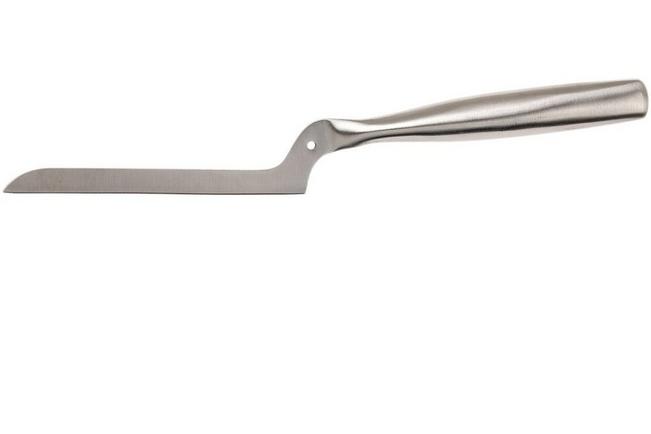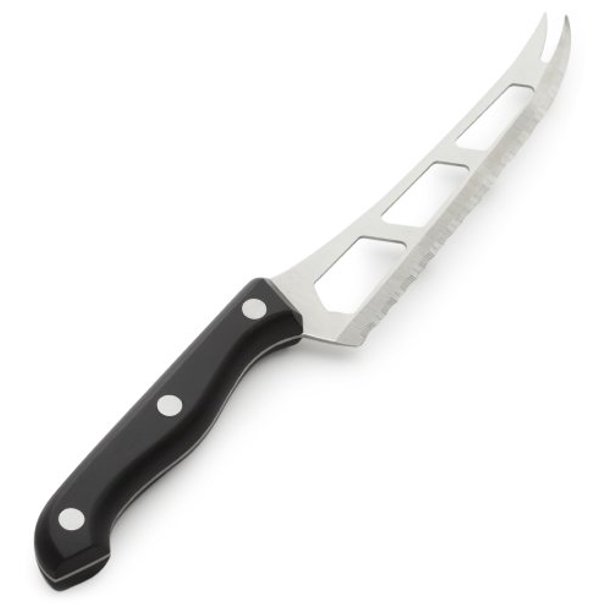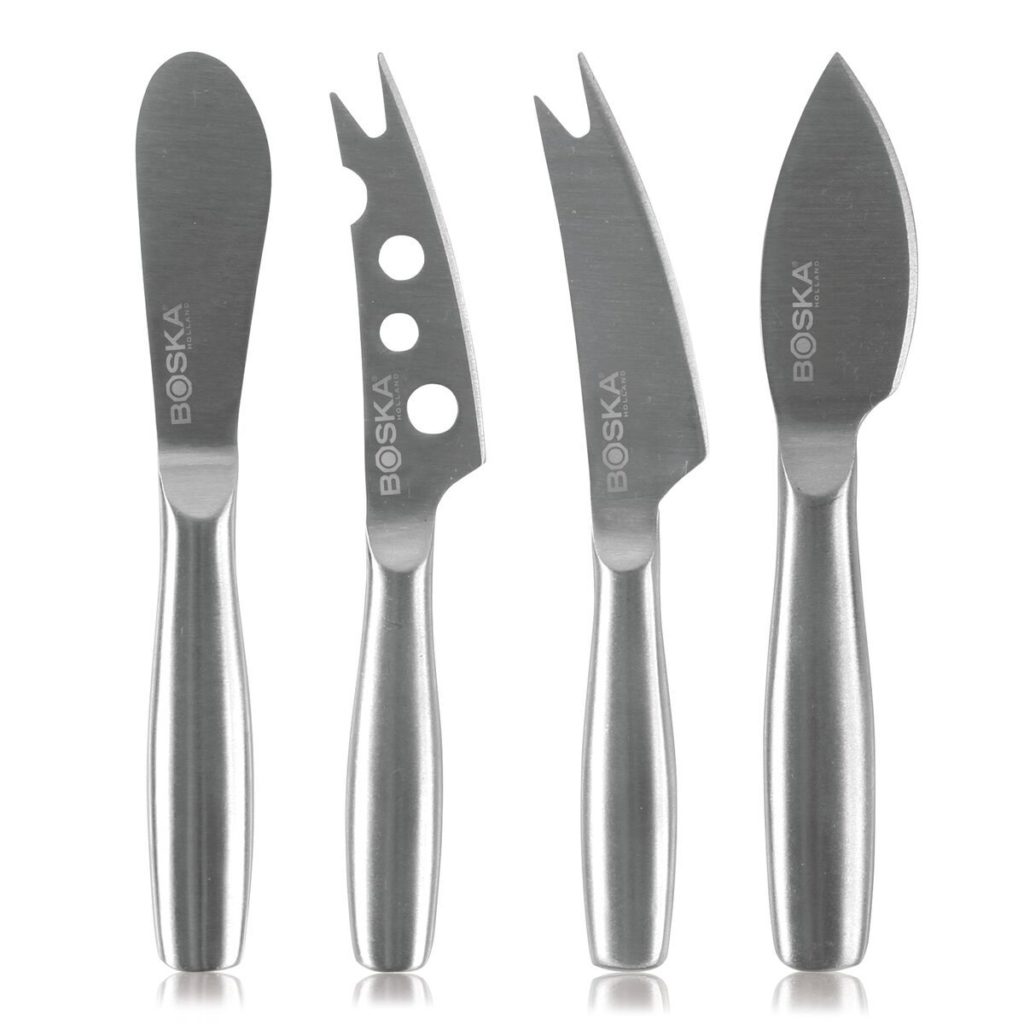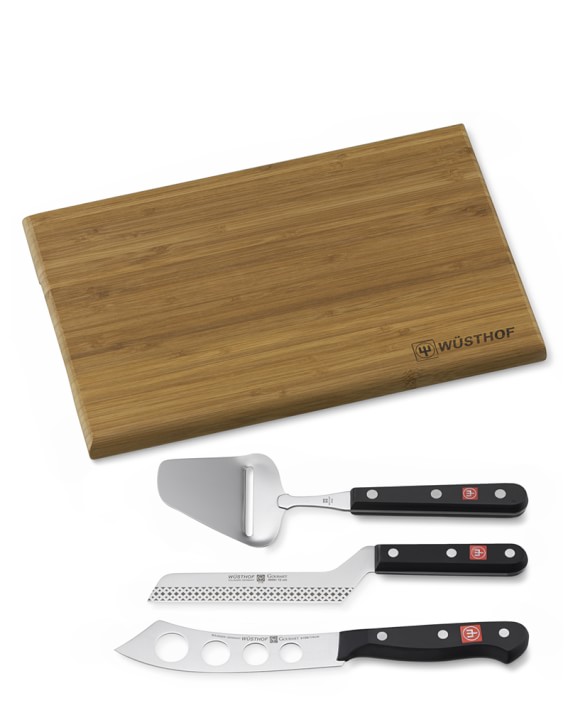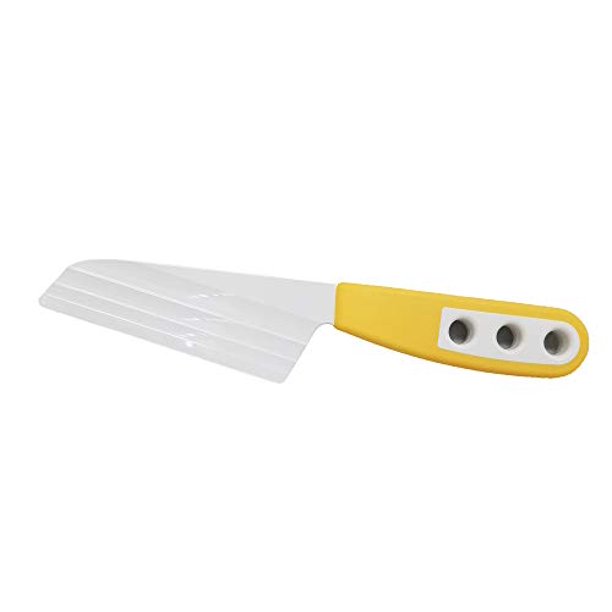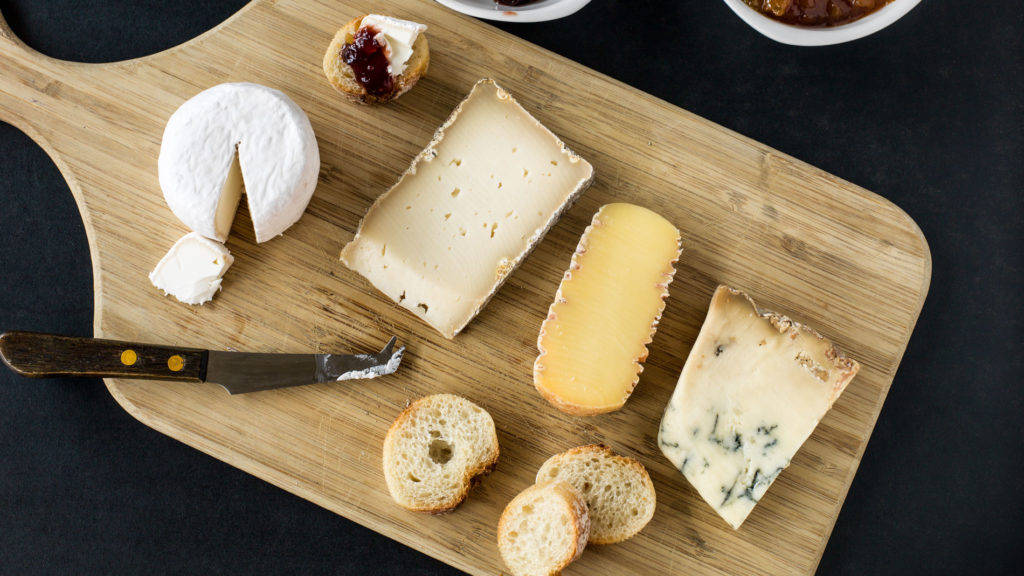
-
Darrian Wilkins
- Last update: January 7, 2022
Disclaimer: we may receive commissions from purchases made via our links at no cost to you
Why do I need special knives for cheese?
Just like there are different knives for preparing different meats and veggies, you need special knives for prepping cheese, especially because different cheeses have different textures. For instance, with a hard cheese like Parmesan or Comte, you want something that can break it into smaller chunks or even more refined wedges.
With a soft cheese like Brie or Fresh Mozzarella, you want something that can slice it nicely without crushing/mashing it or spreading it far. In other words, using the correct knife is important as it preserves the cheese’s structural integrity and consistency, and allows you to also enjoy its full flavor and taste.
Traditional knives will suffice, but won’t give you the best results. A steak knife, for instance, doesn’t have enough oomph to cut through hard cheeses – a cleaver would be the best bet. Your average table knife, on the other hand, will crush a soft cheese like Brie as it lacks the right finesse to gracefully glide through it. So, you certainly need a special knife that can make the most of your cheese’s characteristics, whether it’s firm, grainy, soft, or extra sticky.
There are many different types and options on the market which can be a bit confusing to know which is suitable for what. That’s why we’ve put this guide together. We’ll share the different options available as well as the cheeses they match with, plus what to consider when picking one and more other useful information, including some of our top picks.
What are the things to consider when choosing a cheese knife?
When looking for a knife for cheese, you need to pay close attention to certain things to ensure you get the best and right knife. These main considerations include:
Cheese Type
Before you begin shopping for a cheese knife, you need to first consider the type of cheese or cheeses you serve more often because each knife type is designed for different purposes. The blades that can easily cut harder cheeses might not be able to properly slice soft cheeses.
A hard cheese such as Cheddar will need a more substantial knife featuring a rectangular blade with a sharp, long edge. Cheese that is excessively hard such as Provolone and Asiago need a more robust knife with a long straight blade and sharp edge. Soft cheeses will need a knife with a sharp edge and holes in the blade to prevent sticking while very soft, spreadable cheese will need a knife with a rounded blade and dull edge, like a cheese spreader.
There are also multipurpose cheese knives which could tackle all those tasks. They are designed such that you can use different parts of the blade based on the kind of cheese you are working on – they can handle both hard and soft cheeses. Generally, the idea here is to ensure you select a knife that suits the type of cheese you’ll be using it for. That applies to the multipurpose cheese knife too if you opt for it – the blade layout should suit the different types of cheese you’ll be working with.
Quality of Material
Cheese knives are made of various materials, which include stainless steel, resin, and plastic. Of all these materials, stainless steel is the most common and the best choice because it’s usually sturdy, durable, and sharp. Stainless steel is also highly resistant to rust and corrosion and it’s easy to clean.
It’s non-reactive too, so it doesn’t react with food/cheese to contaminate it and ruin its overall taste. At times, stainless steel blades are reinforced with non-stick coating to enhance performance and corrosion resistance. They are able to generally withstand prolonged usage with just basic maintenance.
Resin and plastic knives are not quite durable as stainless steel. However, resin is stronger than plastic (cracks easily) which makes it a relatively better option, even though both have almost similar characteristics. Porcelain knives are durable and can work well, but they usually cost more than knives made from the other materials.
The Handle
The knife handle is an important factor to look at considering that cheese slicing needs precision. You need a knife with a secure and comfortable handle for safety and practical usability.
Handle Design: First, you should pay attention to the design of the handle. It should be ergonomic with features like contoured shape, indents, or holes to ensure a strong but comfortable grip. A soft handle is usually recommended but the surface should be slightly textured to facilitate a non-slip grip.
Handle Size: For better comfort, you should also pay attention to the size of the handle. A large handle is often ideal, but it’s much better if it exactly fits your hand as some knives are quite small with short handles that suit those with small hands – if you have large hands, they could be a problem. Generally, you should go for a handle that’s nearly two-thirds the length of the blade as this will offer a perfect balance and control while using or moving the knife.
Handle Material: Some knives come with wooden or plastic handles while others feature stainless steel construction throughout the entire knife including, the handle. Each of these materials has its advantages and disadvantages. Wooden handles are the most comfortable because they are usually lighter, firmer, and softer than metal handles. The downside is that they are often not durable and tend to absorb moisture, plus lots of gunk can get caught between the blade and the handle. Wood handles also need periodic oiling to prevent cracking.
Metal/stainless steel handles offer substantial weight and sturdiness. They are more durable and do offer a better grip. A rounded metal grip is ideal if you are not certain which material to go for as it provides enough comfort and security. The problem though is that metal handles can be slippery sometimes, especially when they are wet or when cutting soft or creamy cheese and it gets to the handle.
Overall, your decision here lies in your personal preference. However, you want to ensure you pick a knife with a handle that offers a secure and comfortable grip, and it’s sturdy and durable if you would be cutting hard cheeses often. Look for one with a finger guard or large bolster that will keep your hands far from the blade and as well allow you to cut efficiently.
Set vs. Individual Knives
The number of cheese knives to get will depend on your particular needs as well as your level of experience or skills with knives. For instance, if you’re a frequent entertainer and you often serve a fair number of different cheeses, then it may make sense to purchase a set rather than individual knives. They’ll not only look better together when they are placed out but they’ll also make things simpler.
If you’re a beginner, probably a set of four knives will suit you best as it will have all the basic essentials. You can go further and get a six-piece set in case you want more knife variety. If you’re an expert or a professional chef, then an eight-piece set would suit you well. The diverse variety of knives in such a set will allow you to experiment with various types of cheese.
The types of knives that should be included in the set will largely depend on your cheese cutting needs. Nevertheless, a good set should include knives that are able to at least cut a small variety of cheese. It should include at least a hard cheese knife, a soft cheese knife, and a spreader – these are standard knives for cheese that would service most needs. If you are dealing with rare cheeses, then you might look for a set that includes some special knives.
If you only serve cheese occasionally, or you mostly eat it as a snack, then it will make more sense to get individual knives based on the type of cheese you serve and add on when you need a certain kind of knife.
Different Types of Cheese Knives
There’s a wide variety of knives specifically designed for almost every type of cheese. The classification is a broad one, but here are the main ones based on the various cheeses they handle.
Soft Cheese Knife
It’s also called an open work blade knife and it’s specially designed to handle soft cheeses which are naturally sticky. It features holes in the blade in order to reduce friction and to provide less surface area where soft cheese can stick to. You can gently release/push a slice or piece of cheese off the blade without breaking it. The blade is usually thin and narrow with a slight curve and a very sharp edge to cleanly cut the cheese without using much force or causing structural changes to the cheese. Some also feature a forked tip for picking up and serving slices of cheese after cutting or for breaking off small chunks of cheese.
Cheese Hardness: Soft to Semi-Soft
The Ideal Cheeses: Brie, Fresh Mozzarella, Camembert, Robbiola, Stracchino, Taleggio, Epoisse, Goat Cheese, Gorgonzola
Cheese Spreader
This is also referred to as a spatula knife and it features a short, rounded, flat blade with a dull edge. It’s used for applying creamy or very soft, spreadable cheeses onto bread and crackers. The blades are flexible, so they gently flex when you apply pressure giving you even more control as you spread the cheese.
Cheese Hardness: Soft
The Ideal Cheeses: Stracchio, Cream Cheese, Brillat-Savarin, Epoisse, soft Gorgonzola, Robiola
Gorgonzola Knife
Similar to a cheese spreader, the Gorgonzola knife is built for spreading soft (creamy) and semi-soft cheeses. It has the same rounded blade but the edge is curved and sharp, not dull. The blade is longer with a wider spatula-like face to help keep the soft cheeses on the blade while scooping and also to allow for easy spreading.
Cheese Hardness: Soft/Creamy, Semi-Soft, and Crumbly
The Ideal Cheeses: Gorgonzola, Blue Cheese
Slim Blade Cheese Knife
This is also known as an offset cheese knife and it features a thin narrow blade that has a sharp edge. The blade is sturdy and sharp enough to cut through firm cheeses, but also thin enough to offer a very little surface area where delicate soft cheeses are less likely to stick. The handle is significantly offset from the blade to prevent the knuckles from ever hitting the cutting board. The offset handle as well provides sufficient room to allow for better control, leverage, and consistent clean cuts.
Cheese Hardness: Soft to Semi-Hard
The Ideal Cheeses: Boursault, Camembert
Flat Cheese Knife
This is also called a chisel knife and it features a wide, flat blade with a paddle-like shape. It’s pretty similar to a cheese cleaver knife but the blade has a single sharp edge (can be top or bottom edge). It’s also known as a chisel knife since you have to hold the blade vertically, directly over the cheese, and push it down to chip away at it in one motion. It’s often used for cutting, shaving, or chipping semi-hard and crumbly cheeses that are thick and large into cubes. It’s also often used for aged cheeses. The flat, short blade allows you to apply force directly down on a small area to cut small pieces or slices without crushing the surrounding cheeseboard accompaniments. The flat surface can also be used for scooping and spreading softer cheeses if needed.
Cheese Hardness: Semi-Soft to Semi-Hard
The Ideal Cheeses: Swiss, Provolone, Gruyere, Asiago, Gouda, Cheddar, semi-mature Pecorino. Work also well with Gorgonzola, Romano, and semi-hard Blue cheeses
Pronged Cheese Knife (Fork Tipped Spear)
This features a narrow, upward-curled blade that has a sharp edge and pronged end. It’s a multi-purpose cheese knife that cuts nearly everything from the firm, aged cheese to soft cheeses. The pronged tip (two prongs) can be used for picking up cut cheese for serving or plating. It can also be used for splitting/breaking big cheese blocks. The blade, however, is not strong enough for handling hard cheeses. It may as well be a little thicker for soft cheeses but it can still slice them effectively.
Cheese Hardness: Soft to Semi-Hard
The Ideal Cheeses: Parmesan, Brie, Muenster, Feta
Narrow Plane Knife
This is also called a trapezium knife and it’s almost similar to a flat cheese knife except that it features a narrow blade that’s more rectangular and it’s double-edged. It has a short and long edge both of which are sharp. The knife is used for cutting cheese and also for chipping away at larger blocks.
Cheese Hardness: Semi-Soft to Hard
The Ideal Cheeses: Cheddar, Jarlsberg, Gouda
Cheddar Cheese Knife (Mini Cleaver)
Also known as a semi-hard cheese knife or a cheddar cleaver, this knife features a wide, flat, rectangular blade that’s significantly heavy and has a sharp, long edge. It looks quite similar to a mini meat cleaver with an ergonomic handle positioned such that it prevents the knuckles from hitting a cutting board. It’s used mainly to cut hard and semi-hard cheeses, particularly Cheddar. The wide blade as well as the cleaver shape allows you to use enough force and balance to directly push down the blade and cut slices. It makes cutting and breaking larger and hard pieces of cheese a breeze. The knife also works well with cheeses that feature a smooth interior but with little rind. The sharp edge is sometimes a bit curved right in the middle so as to score the rind first.
Cheese Hardness: Semi-Hard to Hard
The Ideal Cheeses: Cheddar, Fontina, Gouda, Gruyere, Brick, Emmenthal, Colby, Edam
Hard Cheese Knife
This is one of the largest knives for cheese. While they vary in design, the hard cheese knives typically have a long straight blade that’s thick and broad with a sharp edge and a square tip. They usually resemble a miniature cleaver with a rectangular shape. The blade has a substantial feel and it’s strong and sharp enough to cut through hard, aged cheeses. The heavyweight allows it to apply greater force while the rectangular shape is made for straight and stable vertical cutting in a downward motion. It basically allows you to cut large, firm block cheeses into smaller chunks or even more refined wedges. The sharp, thick, heavy blade helps prevent any potential slips and accidents when force is applied, unlike when using a thin, flexible blade to cut hard cheese. Some of these knives also have two handles (on both ends) to ensure even pressure when cutting.
Cheese Hardness: Hard
The Ideal Cheeses: Asiago, Provolone, Comte, Extra Mature Cheddar, Manchego, Pepper Jack, Gruyere, Mature Pecorino, Piave, Mature Toma, Sea Hive.
Parmesan Cheese Knife
It goes by many names, including an almond knife, spade knife, heart knife, and pear knife. All these names refer to the same thing, which is a knife with a short triangular-shaped blade that has a sharp edge ideal for cutting cheese rinds and a pointed tip for breaking off chunks of firm/tough, dry cheeses, particularly Parmesan. Note that, unlike the other hard cheese knives, the Parmesan knives use a chunking method instead of slicing. Very hard cheeses don’t cut easily, so breaking them off into small chunks is easier and as well provides a more rustic presentation. These knives are available in two different styles: There’s the bell cheese knife, which is also referred to as an almond or pear-shaped knife. It has an arrow-head-shaped blade that’s short, strong, and sharp. The other is the compact cheese knife which is also called the spade knife and it features a blade that nearly resembles a shark tooth. It’s short and just as strong and sharp as the bell cheese knife. Both are heavy-duty cheese knives and perform the same function, which is cutting hard cheeses. They are able to score the rinds of tough cheeses, divide wedges, open wheels, and chunk them into small/bite sizes while maintaining their structure and granular consistency.
Cheese Hardness: Hard
The Ideal Cheeses: Parmesan, Grana Padano, Castelmagno, Romano, Vintage Gouda, Pecorino, and other mature cheeses that have a hard, grainy, chalky interior.
Best Knives for Cheese
LUNAR Premium 6-Piece Cheese Knife Set
This Lunar Premium 6-piece set offers the best value when it comes to cheese knife sets. At a modest price, you get 4 quality cheese knives which include a soft cheese knife, pronged knife, parmesan knife, and a broad flat knife. With these knives, you can handle nearly all manner of cheeses, from soft to very hard cheese. The knives are very sharp, capable of efficiently cutting very thin cheese slices or breaking off very hard cheeses into small chunks. The set also includes a cheese spreader and a cheese fork, so you get literally all the essential cheese tools you need in one package.
All the knives are 100% stainless steel from the blade to the handle which gives them a clean, polished look that’s quite attractive. They are strong and highly durable, plus the stainless steel is rust-proof and wear-proof. The handles are robust and ergonomic. They are short and rounded to offer a good, comfortable grip for small and medium hands. The weight distribution is even all through the knives which improve balance for precise cuts. Overall, this is a great one-size-fits-all option that’s ideal for those looking for an affordable yet reliable set. It offers significantly more value, especially considering everything that’s included and the price.
W&P Premium Steel Cheese Knife
This is a reliable choice for those hard, aged cheeses. It features a 7-inch long, rectangular blade that’s thick, and broad with a fine sharp edge. It has a gentle hefty feel to it which provides enough power for the sharp edge to cleanly cut through firm cheeses like Asiago, Provolone, and Comte. The sharp pointed tip also allows you to easily break pieces off most blocks of hard, aged cheeses or crumbly cheeses like Pecorino Romano. The scallops on the blade also help reduce friction when cutting and also keep the cheese from sticking to the surface of the blade. The blade itself is very durable, made of stainless steel and its edge doesn’t dull quickly.
The handle is a polished hardwood that’s held firmly to a full tang with three brass rivets and it has a metal plate at the end and a fairly large bolster. The grip is solid and comfortable, making any cut secure and easy. The handle is weighted pretty well too and balances out the wider, heavy blade, leaving you with a knife that feels comfortable in the hand. It doesn’t cause fatigue over prolonged use. The hardwood is really durable and bacteria-resistant, plus offers sufficient slip-resistance for daily use.
Boska Soft Cheese Knife
This Boska knife is specifically designed to cut/slice soft cheeses which it does effectively. It has an extremely thin blade with a very sharp edge. It easily glides through soft cheeses without creating friction or sticking. The thin blade significantly minimizes the surface area for soft and sticky cheeses to stick to, even the creamiest of cheeses. It’s able to slice a decent portion of the cheese without squashing it or causing it to crumble. It’s ideal for both soft and semi-soft kinds of cheese such as Camembert and Brie.
The thin blade is 100% stainless steel. It’s sturdy and sharp enough to even cut into semi-hard cheeses in case you’re in a pinch. It’s strong, durable, and resistant to rust or corrosion. The handle is also entirely stainless steel and it’s offset from the blade to keep the fingers from hitting the cutting board and also away from the sharp blade. It’s well-balanced, smooth, and slightly contoured to offer a comfortable grip and better control when slicing or cutting.
Other Recommendations
1. Prodyne CK-300 Multi-Use Cheese Knife
Pros
- An all-rounder knife ideal for both soft and hard cheese
- The sharp serrated edge gets even sharper over time
- Cheese doesn’t stick to the blade when cutting
- The blade is sturdy and durable, made of stainless steel
- Has a strong, durable handle that’s comfortable to hold
- The handle provides a firm, non-slip grip
Cons
- The handle may be a bit large for those with small hands
- The blade can rust if not well taken care of
- The handle may be a bit slippery when wet
- No protective sleeve included
Why do we recommend it
The Prodyne CK-300 offers great value for money because of its versatility. It’s an all-around knife that’s not only perfect for different types of cheeses but also fruits and hard vegetables. It’s pretty unique in its design. It features an open-surface stainless steel blade with a serrated edge and a tapered tip that separates into two prongs. The serrated edge is super-sharp and makes cutting into cheese an easy task. It can cut through both hard and soft cheese, plus the blade is thin and strong enough to produce perfect thick or thin slices of cheese. It can even cut through tougher fruits and vegetables.
The three large holes of the blade help reduce friction while cutting and prevent cheese from sticking right onto the blade and also from breaking. The forked tip helps in picking and serving the cut pieces of cheese once they fall off the blade. The knife comes with a Bakelite handle that’s secured to a full tang by three rivets, making it strong and durable. The handle has an ergonomic design, featuring a contoured shape that’s comfortable and easy to hold, plus offers a solid and fairly non-slip grip. The Bakelite material is heat resistant and doesn’t wear quickly.
2. Boska Copenhagen Mini Knife Set
Pros
- Four-piece set that can handle soft to hard cheeses
- The blades are sharp and have good edge retention
- Strong and durable stainless steel construction
- All the knives are resistant to rust, corrosion, and discoloration
- The handles are solid and comfortable to hold
- The hollow design of the handle makes the knives lightweight
- The set comes with a 10-year warranty
Cons
- Handle size might be a little too small for some
- The handles are not non-slip, especially when wet
Why do we recommend it
The Boska Copenhagen Mini knife set is a suitable option for a kitchen that usually handles different types of cheeses. It’s very versatile, consisting of four different knives that allow you to cut nearly all types of cheeses. They include a soft cheese knife, pronged cheese knife, parmesan knife, and a cheese spreader. These four knives can handle soft to hard cheeses including semi-hard, semi-soft, and spreadable cheese. They are all made of stainless steel that’s strong, durable, and rust and corrosion-resistant. The blades, except for the spreader, are sharp and deliver clean, thin slices of cheese whether it’s soft or hard cheese.
All the knives have stainless steel handles that are nicely rounded to fit comfortably in the hand in an ergonomic position. The shape makes the grip pretty secure and handling convenient, although it can be slippery when the handles are wet. The handles are all hollow on the inside, making the knives lightweight and easy to hold. If you are running a small restaurant, bakery, or just need an affordable and capable cheese knife set, then this is a great option.
3. Wusthof Gourmet Four Piece Cheese Knife Set
Pros
- Works great for soft to semi-hard cheeses both small and large
- Super sharp blades that can keep their sharpness for long
- The blades are sturdy, durable, and resistant to corrosion
- Strong, comfortable handles that offer a secure grip
- The handles’ size is great for both small and large hands
- All the knives are well balanced and don’t cause fatigue
- Comes with a limited lifetime warranty
Cons
- The board is made of softwood and is a little flimsy
- Not quite ideal for cutting very hard cheeses
Why do we recommend it
This Wusthof Gourmet cheese knife set comes at a reasonable price and although it isn’t as versatile as the Boska Copenhagen Mini knife set above, it still offers three handy cheese knives that are able to handle soft to semi-hard cheeses. The set includes a soft cheese knife that has a sharp blade with holes throughout to stop delicate cheeses from sticking on it and an offset cheese knife featuring a straight and sharp blade that’s strong enough to cut through semi-hard cheeses and also some hard cheeses. There’s also a cheese plane which is more of a cheese tool that allows you to thinly slice cheese. All the knives are well made. They are large enough to handle small to large cheese blocks
The blades are made from high carbon stainless steel that’s fairly sturdy and durable, plus it’s resistant to corrosion. The blades of both the soft and hard cheese knives are razor-sharp and can keep their sharpness for years with proper care. The knives have synthetic polypropylene handles that are triple-riveted to a full tang. They feel comfortable to hold and offer a good grip and control over the knife when cutting. The polypropylene material is of good quality. It’s not likely to fade or discolor over time and it can withstand high heat and impact. We liked this set too because it includes a bamboo cheese board which is quite a useful tool when it comes to cutting cheese.
4. The Cheese Knife OKP2
Pros
- Sharp, strong blade that can cut soft to semi-hard cheeses
- Unique ridged blade design to keep the cheese from sticking
- The blade is sturdy and resistant to stain and rust
- Handle offers a soft, secure grip that’s comfortable and non-slip
- Fairly well balanced to reduce stress on the hands and wrist
- It can withstand high temperatures of up to 430 degrees Celsius
Cons
- Both the blade and handle aren’t very durable
- Won’t work well on hard, aged cheeses
Why do we recommend it
The OKP2 is a multipurpose knife that’s able to slice soft and semi-hard cheeses, although it’s much better for soft cheeses like Brie. It has a large blade that looks nearly like a mini cleaver. It’s sharp and rough, plus it features subtle steps leading to the edge which is a distinct design, different from other standard cheese knives. This design allows it to easily slice soft, sticky cheeses without making a mess or the cheese sticking to the blade. The ridged blade is sturdy and sharp enough to also easily cut through semi-hard cheeses. Plus, the ridge design helps the knife maintain the thickness of the slice when cutting – you get nice, even slices of cheese.
The blade itself is made of stainless steel which is sturdy and rust-resistant. The handle is made of a plastic material that feels soft in the hand and it’s equally designed with a unique style as it features three holes in it that offer a comfortable, anti-slip grip while slicing cheese. The yellow handle fits very well in the hands and feels really secure holding it, plus the knife is lightweight and well-balanced, so you don’t feel fatigued using it over a prolonged time. The length of the handle is around 4-inch long, hence it’s perfect for small to medium hands.
Other Tools in a Cheese-Cutting Set
Some cheese knife sets come with additional tools that can be used to cut and serve cheeses. The most common types you may encounter are:
Cheese Wire
Also referred to as a bow knife, a cheese wire is purposely made for cutting extra soft cheeses like Mozzarella without crushing/mashing them or spreading them far. It can come in a bow shape where the wire is tied to the far ends of a wooden (flexible) strip or attached directly to a cheese board that has an indent for the wire. You just lower the wire down gently through the cheese to cut it, leaving a clean slice behind.
Cheese Hardness: Soft to Semi-Soft
The Ideal Cheeses: Ricotta, Robiola, Fressh Mozzarella, Stracchino, Soft Goat Cheeses
Cheese Plane
Features a spatula-like paddle shape (almost similar to a flat shovel) with a sharp-edged slit right in the middle or sometimes close to the bottom. It’s designed for making thinly sliced pieces of semi-soft cheeses like Fontina and even semi-hard ones like Gouda. It’s the best way to achieve consistent, razor-thin slices of cheese. You just pass the plane along the side or the top of the cheese to slice it and the slice will then simply sit on the top of the plane’s spatula-like surface when it’s complete, making it easy to serve or plate.
Cheese Harness: Semi-Soft to Semi-Hard
The Ideal Cheeses: Havarti, Fontina, Muenster, Gouda
Cheese Rind Cutter
A rind cutter comes with a pointed downward tip (hooked tip) and sharp edge. The pointed tip is sharp enough to pierce through a cheese rind and then cut through it smoothly, making it easier to open. It can be used on almost any cheese that has a rind but it’s typically used for hard cheeses. It works best with larger wheels of cheese, especially Parmesan and Grana Padano, plus it can be used along with Parmesan cheese knives. To use it, you simply pierce the cheese rind at one edge and then drag it cleanly across the rind surface. It makes slicing the rind off cheese much more straightforward.
Cheese Hardness: Semi-Hard to Hard
The Ideal Cheeses: Parmasan, Parmigano Reggiano, Grana Padano
Cheese Grater
A cheese grater usually consists of several sharp razors positioned on a flat plane and it’s used for creating shreds of cheese. The razors are often on different parts of the plane to produce different size shreds as you press the block of cheese down against the grooves. It’s used on hard cheeses but you can also use it to shred various other foods.
Cheese Hardness: Semi-Hard to Hard
The Ideal Cheeses: Romano, Parmesan
Cheese Fork
The cheese fork resembles a large fork. It features two pointed prongs and a short handle. It’s helpful in a cheese board, mainly for picking up large chunks or pieces of cheese for serving or plating. You can also use it to break up aged cheese blocks into smaller chunks.
Cheese Hardness: Semi-Soft to Hard
The Ideal Cheeses: Cheddar, Provolone, Feta, Gouda, Parmesan
How To Clean and Take Care of a Cheese Knife
What to do after using a cheese knife?
It’s best to clean any knife after each use to ensure its longevity and the same thing applies to cheese knives. The most suitable way to wash them is by hand using warm water, mild dish soap, and a soft sponge that can wipe away any residue. Once you have the knife washed and rinsed, you hand dry it thoroughly before storing it. Hand washing and hand drying your cheese knives this way will reduce the chances of rust and also ensure the longevity of the blade.
Some knives may claim to be dishwasher-safe but unless you are certain that they are, it’ll be best to stick to hand-washing and hand-drying, especially if you’ll need to clean it frequently, like after everyday breakfast. The dishwasher can be rough on the blades and dull them over time, so it would be best to wash the knives by hand to preserve their integrity.
Where to store cheese knife after use?
Storing cheese knives is just as important as cleaning them after use. The consideration here is whether your knives will be safe where you store them. You need to keep them in a place that will help ensure the blades remain sharp and damage-free while at the same prevent you from accidentally cutting yourself when removing or putting them back after use.
Some cheese knife sets can come with a storage container, which is one reliable way of keeping the knives safe and in good shape when not in use. You can also consider getting a knife block or a more lasting storage case to keep them in. Some knives also do come with storage boxes which you can as well use to keep them.
Drawers also do provide great storage for cheese knives. However, sliding them into the drawer together with other utensils could cause damage to the blades, so you may need to get protective sleeves which could help keep them safe when they collide with the other utensils.
FAQ
How long do cheese knives last?
When taken care of properly (hand-washed, hand-dried, and sharpened whenever needed), cheese knives can certainly last a lifetime, if the quality of both the blade and handle is great. In fact, many of the high-quality models like the Wusthof Gourmet cheese knife set above come with a lifetime guarantee, as well as lifetime sharpness like the Prodyne CK-300 multi-use cheese knife.
Do you have to get cheese knives sharpened?
Most cheese knives don’t really need to be sharpened. Proper usage, cleaning, and storage are often all it takes to ensure that the knife stays sharp for long. However, even the best cheese knife can lose its sharp edge over time. Based on the quality and type of the knife, how often it’s used, and the type of cheese it’s used on, a cheese knife typically should be sharpened after around every one to two years. Knives used for hard cheeses may need sharpening at least every year, especially if used frequently.
Cheese knives with blades of stainless steel can usually be re-sharpened at home and would come with their own instructions for sharpening. You’ll have to invest in a good knife sharpener to get the job done. If you are not certain of your DIY sharpening skills or worry about damaging your knives, you may hire a professional knife sharpener to sharpen them for you. You may also prefer a professional knife sharpener if your cheese knives are made of porcelain or other delicate blade materials.
Can I use the same knife for different cheese?
Yes. There are multipurpose knives that are built such that you can use different parts of the blade on different types of cheese. A good example is the flat cheese knife which is designed almost like a cleaver with a sharp edge that can be used to cut, shave, or chip semi-hard cheeses. It also has a flat, short blade that can be used for scooping and spreading softer cheeses. It’s one knife that you can use on soft to semi-hard cheeses. Generally, if you opt for a multipurpose cheese knife, consider the blade to ensure that you will be able to use it to cut the different types of cheese you prefer.


